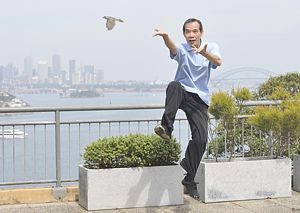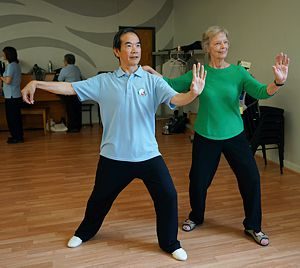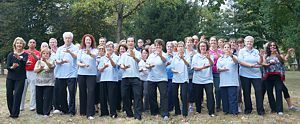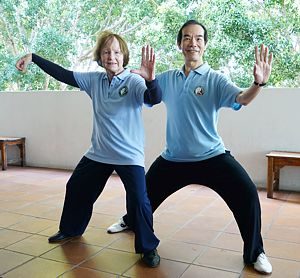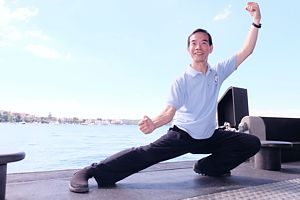Tai Chi for Everyone
A VIDEO BY DR PAUL LAM: (click on the link to see the video)
Dr Paul Lam, a family physician in Sydney, Australia, is dedicated in tai chi for health improvement. He has composed several Tai Chi for Health programs that have improved millions of people’s quality of lives. The Centers for Disease Control and Prevention, National Council On Ageing, Arthritis Foundations and many health departments around the world support his programs.
INTRODUCING: This video starts with Dr Lam demonstrating 6 of the 12 movement Tai Chi for Arthritis program, he then 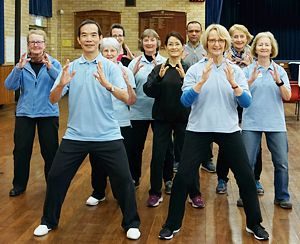
He shares his journey in tai chi. Dr Lam has arthritis from 13 years old due to chronic malnutrition, and tai chi has transformed his health. That is why he is so passionate about Tai Chi for Health and to make tai chi easier to learn, improve health quickly and more enjoyable.
Dr Lam and colleagues found the key reasons why tai chi work so well, have participated in research studies and published their work in medical journals. Dr Lam and colleagues have also made tai chi accessible to everyone including anyone with disability.
At the conclusion, Dr Lam demonstrates the more vigorous tai chi to show that at the age of 72, after having arthritis for 59 years, he can still get stronger, fitter and more flexible.
BELOW IS THE TRANSCRIPT OF HIS VIDEO:
That was 6 of the 12 movement Tai Chi for Arthritis program.
Tai chi is a mind body exercise originating from ancient China. There is a lot of myths about tai chi. Many people think it is complex, difficult to learn, mysterious and beautiful.
Professor Callahan from the University of North Carolina has done a study on tai chi and arthritis. It was the largest study of its kind with 354 people and she teach them (she didn’t teach them; the instructors teach them) the 12 movement Tai Chi for Arthritis in eight weeks. Not only the tai chi group have learned the program, they also gained significant benefits in less pain from arthritis, they can do more of their daily activities and they have better balance and, what is really important, they feel better about themselves.
Comparing with the other group (participants are randomly assigned to do tai chi or to wait), it shows the program is easy to learn, not complex and its very quick to give benefits.
I learned tai chi for my arthritis 45 years ago. Back to the time when I was 10 months old, my parents left me in a small Chinese village with my grandmother and my aunt. Grandmother was later classified as a landlord and our family became the “enemy of the people”, and I lived a pretty miserable childhood. By the time I was ten years old, around the time the Great Famine came, and we were struggling for years to survive. Chronic malnutrition from all these years of starvation gave me arthritis. I was lucky; I escaped China and came to the beautiful country of Australia. I won a scholarship to study Medicine. By the time I graduated, when I became a doctor, just to carry that little medical bag was a challenge, my arthritis was so bad. I knew that I am not going to be able to do what I want to do. In future I would be looking at joint replacements, medication and probably by 40, I could be a cripple.
I did not want that; I want to fight against that and that was the reason I took up tai chi in the hope of improving arthritis. The myth was right, it was challenging to learn tai chi and the ones I learned was complex, and it took a long time, around 3 years before my arthritis was getting better. Then together like a package, I also have so many aspects of my health improved. For example, my immunity was shattered from years of malnutrition. When I was doctoring, I would see patients and caught their illness, such as upper respiratory tract infections and I would be sick for two to three weeks, then I recovered from that and one week later I caught another virus. As I get better, gradually I get less and less infection. In fact, occasionally I felt I got something from my patients with a little fever, running nose and sore throat. I would do a bit more tai chi and next morning I would be fully recovered. It is good for me; I got a lot more than I bargain for. I went to find better way to manage my arthritis and ended up my health and my life was transformed.
Something this good I have to share, I developed this burning desire to share with my friends, my patients and with as many people as possible. But I knew in order to reach many people, tai chi needs to be easier to learn, quicker to bring results and more enjoyable.
So we worked really hard. I attempted, and because tai chi is so enjoyable, I learned many styles and forms. I want to understand the depth and the width of tai chi. When you truly understand something, you can find out how it works and then we can find ways to make it shorter and more effective for health, like the Tai Chi for Arthritis program. Fortunately, many of my medical colleagues especially the physical therapists, occupational therapies, doctor and nurses and many researcher workers shared the same vision as me and we worked together.
We found that no matter what style, what form of tai chi, the thing that makes tai chi work so well for health is a set of principles. These principles go back to how tai chi was created. It was created based on the law of nature, especially the law of nature of human being. So like nature, it is simple, but it has so much depth for people like me to study tai chi for 45 years and still find interest and passion.
However, once you understand the principles and incorporate the principles into the tai chi – no matter what tai chi – even a very short one, like 12 movements, it will bring you the health benefits and the enjoyment.
The principles, for example, like the tai chi movement are slow, smooth, the slowness allows us to integrate our bodies and mind. In other words, to be mindful and to be present. The smoothness brings a sense of serenity.
Other principles like standing upright seems to be simple but standing upright and supple has many health benefits. First of all, when you are tired or not happy you will often tend to do this (hunch down), but when you just stand up supply, not tense, allow your joints to be open, this posture, most people would instantaneously feel better.
When you stand up like this you have more space for the lungs to expand. You activate the deep stabilisers in the spine, that makes the spine stronger and your body stronger from the inside. As well as that, in terms of the mind, studies have shown that when you are standing upright and moving in an open, confident manner, whatever you chose to do, you have a 20% more chance of success.
Also when moving in larger movements with an upright posture your creativity increases by 20%, which is amazing.
Tai chi puts lots of emphasis on balance, which again is nature. Balance, night and day, light and dark and so on. Improving our balance will reduce falls, especially when we get older. In fact, tai chi is one of only two exercises which have been proven by studies to be effective at preventing older people from falling. There are many other studies showing the Tai Chi for Arthritis program to be effective for many other health benefits, especially in reducing falls for older people.
That is why the Centers for Disease Control and Prevention, the National Council on Aging supports and recommends the Tai Chi for Arthritis program for falls prevention.
Other principles like internal training to develop serenity and tranquillity or facilitate mindfulness. That is why tai chi is so needed in a modern, fast paced life.
Tai chi as created based on nature. It is human nature for us to be fast and slow. Fast for quick action, slow for regeneration and recovery. To be thinking very quickly and also to be mindful, to be slow and serene. That is the balance that we are made with.
For example, when you are hungry, food tastes better. When we are thirsty, water is sweeter.
Modern life is so fast, so unnatural, tai chi brings us back to nature, so we have the slow phase to regenerate and restore (to compliment the fast phase). That would be enjoyable because our body and mind crave for it, like craving for water when we are thirsty.
However, it takes a while to get used to it, once you are used to the slow phase, tai chi can be so enjoyable and so beneficial.
We participated in many research studies to substantiate our findings. Over the last fifteen years there have been over 500 medical studies which have shown that tai chi improves so many aspects of health: relaxation, fall prevention, (reduces cholesterol level, and high blood pressure) preventing diabetes and cardiovascular disease and so on.
Almost all of those studies use smaller, shorter tai chi forms, and they bring benefits relatively quickly. There are now many types of teachers and institutions which utilise shorter, health orientated tai chi sets, teaching them in a learner friendly way so it is more enjoyable.
We especially wanted to make tai chi accessible to anybody, so I worked with my medical colleagues to adapt tai chi for almost any disability. For example, my friend Richard has Guillain Barre Syndrome which was an unusual disease which affected the neurological system. He was lying in an intensive care bed, hardly able to move any part of his body. He visualised Tai Chi for Rehabilitation in his mind and gradually it helped to bring him back to health. So tai chi can be accessible, and anybody can learn it and, more importantly, can enjoy it.
Before I go, I would like to continue sharing my tai chi from where I started, to something more vigorous, the classical Chen Style. Just to show you that at the age of 72, after having arthritis for 59 years, I can still get stronger, fitter and more flexible. So anyone can learn tai chi you will get enjoyment and health benefits more than the effort and time you put into it. BUT you don’t have to do the vigorous tai chi unless you are devoted and want to spend a lot of effort doing what I did.
This is just to show you how much I enjoy the tai chi and the freedom it gives me, even as I grow older.

